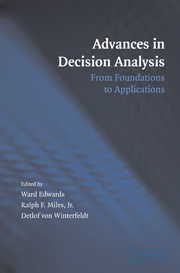Book contents
- Frontmatter
- Contents
- List of Contributors
- Preface
- 1 Introduction
- PART I HISTORY AND FOUNDATIONS OF DECISION ANALYSIS
- PART II STRUCTURING DECISION PROBLEMS
- PART III PROBABILITIES AND BAYES NETS
- PART IV UTILITIES
- PART V RISK ANALYSIS
- PART VI DECISION ANALYSIS IN A BEHAVIORAL AND ORGANIZATIONAL CONTEXT
- PART VII APPLICATIONS OF DECISION ANALYSIS
- 24 The Adoption of Multiattribute Utility Theory for the Evaluation of Plutonium Disposition Options in the United States and Russia
- 25 Choosing a Tritium Supply Technology for Nuclear Weapons: Reflections on a Controversial Decision Analysis
- 26 Applications of Decision Analysis to the Military Systems Acquisition Process
- 27 Balancing Environmental and Operational Objectives in Nuclear Refueling Strategies
- 28 Perspective on Decision Analysis Applications
- Index
- References
25 - Choosing a Tritium Supply Technology for Nuclear Weapons: Reflections on a Controversial Decision Analysis
Published online by Cambridge University Press: 05 June 2012
- Frontmatter
- Contents
- List of Contributors
- Preface
- 1 Introduction
- PART I HISTORY AND FOUNDATIONS OF DECISION ANALYSIS
- PART II STRUCTURING DECISION PROBLEMS
- PART III PROBABILITIES AND BAYES NETS
- PART IV UTILITIES
- PART V RISK ANALYSIS
- PART VI DECISION ANALYSIS IN A BEHAVIORAL AND ORGANIZATIONAL CONTEXT
- PART VII APPLICATIONS OF DECISION ANALYSIS
- 24 The Adoption of Multiattribute Utility Theory for the Evaluation of Plutonium Disposition Options in the United States and Russia
- 25 Choosing a Tritium Supply Technology for Nuclear Weapons: Reflections on a Controversial Decision Analysis
- 26 Applications of Decision Analysis to the Military Systems Acquisition Process
- 27 Balancing Environmental and Operational Objectives in Nuclear Refueling Strategies
- 28 Perspective on Decision Analysis Applications
- Index
- References
Summary
ABSTRACT. Nuclear weapons require the periodic replacement of tritium, a radioactive gas that decays at approximately 5.5 percent per year. Since 1989 the United States had no tritium supply facility, and, because of the decay of tritium, its inventory was expected to fall below the required reserve level in 2011. To decide how to fill this projected gap, the Department of Energy assessed several tritium supply alternatives, including several types of new reactors, an accelerator, and the use of commercial reactors. This paper describes the decision analysis process, conducted in the mid-1990s, to support the decision by the Secretary of Energy to choose among the options. This process involved two rounds of analysis, several surprises and many adjustments. In the end the decision analysis was successful in shaping both the intermediate decision by then-Secretary O'Leary and the final decision by Secretary Richardson.
The Problem
Tritium is a necessary component of all nuclear weapons. Because tritium decays at a rate of approximately 5.5 percent per year, it must be replaced periodically. Over the past 40 years, the Department of Energy (DOE) has built and operated fourteen reactors to produce tritium and other nuclear materials for weapons purposes. In 1988, then-President Bush shut down the last remaining tritium production facility, a heavy-water reactor in Savannah River, GA. Since that time, no tritium has been produced and the DOE had to rely on recycled tritium from existing weapons to replenish decaying tritium sources.
- Type
- Chapter
- Information
- Advances in Decision AnalysisFrom Foundations to Applications, pp. 514 - 538Publisher: Cambridge University PressPrint publication year: 2007
References
- 1
- Cited by



